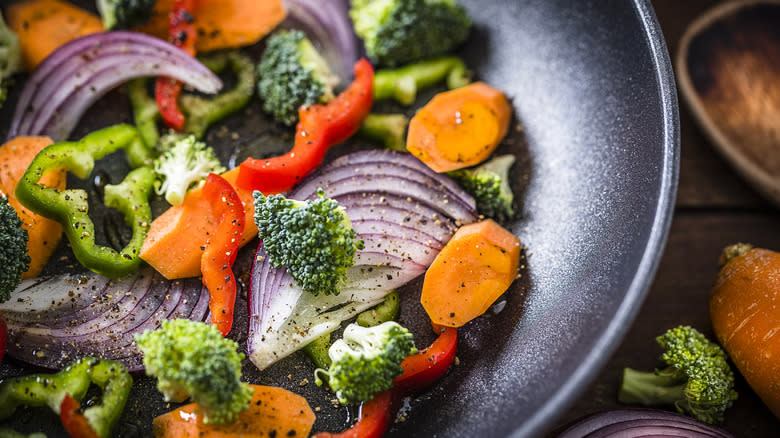If You're Out Of Oil, Try Sauteing With Vegetable Stock Instead

Meaning "to jump" in French, sauteing involves frying food in a small amount of oil. The method cooks food evenly and quickly, browning the outside while still maintaining its texture. Sauteing is moderately healthier than frying, which involves submerging your food in oil. However, if you're looking for tips for using less oil, sauteing still may not seem like the best method.
Although oil is associated with traditional sauteing, you don't actually need to use it. Whether you want to cut down on oil for health reasons or you've simply run out, you can substitute oil with vegetable stock. Derived from the liquid that comes from simmering vegetables and herbs in water, vegetable stock can also be used in place of water when making rice, pasta, beans, and soup. Overall, vegetable stock has a mild, savory flavor. When used while sauteing, the stock provides the food with a light, earthy flavor without making it soggy.
Read more: The 20 Best Olive Oils For Cooking
How To Saute Food With Vegetable Stock

Using a nonstick pan, add a small amount of vegetable stock — just enough to cover the bottom. Sprinkle salt and pepper to taste along with your choice of herbs. When the stock begins to heat up, add your vegetables and stir occasionally. While a nonstick pan should help prevent your food from adhering to the bottom naturally, add some more vegetable stock as it starts to evaporate. Note: Be careful not to let your veggies overcook. Once they reach a crisp, tender consistency, turn off the heat and serve. Using store-bought vegetable stock is easier, but if you want to customize the flavor, you can make your own stock from scratch.
For a balance of flavors, opt for veggies that are sweet, savory, and aromatic. While onions and mushrooms bring a savory, umami quality to stock, don't forget to sweeten things with carrots and tomatoes. To brighten the stock, add sprigs of rosemary as well as fresh thyme and basil. After simmering on the stove for an hour, you can store the stock in the freezer for up to three months.
Read the original article on Tasting Table.